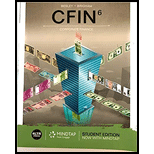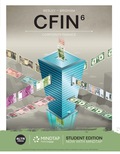
CFIN -STUDENT EDITION-W/ACCESS >CUSTOM<
6th Edition
ISBN: 9780357753118
Author: BESLEY
Publisher: CENGAGE C
expand_more
expand_more
format_list_bulleted
Question
Chapter 4, Problem 8PROB
Summary Introduction
The required amount to buy a new car is $22,000 and the amount to be saved for 3 years at an
Here,
The present value is “PV”.
The
The interest rate is “r”.
The maturity period of time period is “n”.
The no of compounding is “m”.
Expert Solution & Answer
Want to see the full answer?
Check out a sample textbook solution
Students have asked these similar questions
What is the primary goal of financial management in a corporation?A) Maximize salesB) Minimize costsC) Maximize shareholder wealthD) Maximize profits
Dislike...????no ai
what are some of the complications that management should consider when constructing pro forma financial statements.?
Chapter 4 Solutions
CFIN -STUDENT EDITION-W/ACCESS >CUSTOM<
Ch. 4 - Prob. 1PROBCh. 4 - Prob. 2PROBCh. 4 - Prob. 3PROBCh. 4 - Prob. 4PROBCh. 4 - Prob. 5PROBCh. 4 - Prob. 6PROBCh. 4 - Prob. 7PROBCh. 4 - Prob. 8PROBCh. 4 - Prob. 9PROBCh. 4 - Prob. 10PROB
Ch. 4 - Prob. 11PROBCh. 4 - Prob. 12PROBCh. 4 - Prob. 13PROBCh. 4 - Prob. 14PROBCh. 4 - Prob. 15PROBCh. 4 - Prob. 16PROBCh. 4 - Prob. 17PROBCh. 4 - Prob. 18PROBCh. 4 - Prob. 19PROBCh. 4 - Prob. 20PROBCh. 4 - Prob. 21PROBCh. 4 - Prob. 22PROBCh. 4 - Prob. 23PROBCh. 4 - Prob. 24PROBCh. 4 - Prob. 25PROB
Knowledge Booster
Learn more about
Need a deep-dive on the concept behind this application? Look no further. Learn more about this topic, finance and related others by exploring similar questions and additional content below.Similar questions
arrow_back_ios
SEE MORE QUESTIONS
arrow_forward_ios
Recommended textbooks for you

What Does ROI (Return On Investment) Really Mean?; Author: REtipster;https://www.youtube.com/watch?v=Z6ThJvNr1Dw;License: Standard Youtube License